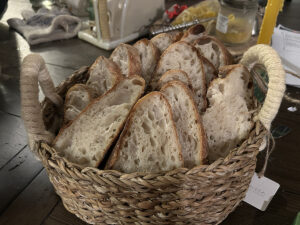
On almost any Monday morning, you’d catch Mom in the kitchen, first filling the old wringer washer with hot water, turning it on, then filling the swishing tub with dirty clothes that hit the suds one by one with a satisfying plop and blurble. Like a hungry monster, the washing machine pulled the clothes downward into the steaming, soapy water. After a moment, they’d rise like undersea monsters, pale colors and shades of white, mounded like the smooth back of some creature… then they’d swish and swoop downward, only to rise and do it again.
As a child, I was fascinated by this powerful machine and when I grew into an adult, the fascination remained. It may sound strange, but there’s something fine and dignified about using a wringer washer. No automatic, close-the-lid-and-ignore-it washing machine can come close to being cherished the way a wringer washer can. It was one of the most efficient appliances to come out of the industrial revolution, and believe it or not, it’s still the most efficient of all laundry methods. These machines came powered by electricity, powered by gas or powered by hand, with or without pumps to empty the water.
They’ve been made with square tubs, round tubs, wooden tubs, aluminum tubs, steel tubs, porcelain tubs and copper tubs. They’ve come with attached wringers or not. The one thing they all have in common is a dasher or agitator on a simple gear that moves back and forth, forcing water through clothing to release dirt, and it works very well.
A wringer washer gets clothes clean in a minimum of time, using a minimum of water and a minimum of detergent. You can do a whole family’s laundry in one morning per week, and not even think about it for another week. It gets grungy clothes clean without having to use spot cleaners or pre-washes or soaks or whatever. When one speaks of quality wringer washers, Maytag has always been the one to beat, although there were several other manufacturers.
Unfortunately, Maytag doesn’t make wringer washers any more (the last one rolled off the production line in 1983), but you can still find old machines that work because they were made to last. If you can’t find a working one, Lehman’s sells reconditioned Maytags, as well as parts for them. The best news is that brand new wringer washers are still being made today. They’re not quite the same as the old Maytags and they’re not made in the US, but they’ll get your clothes cleaner, faster, and cheaper than any automatic washing machine ever made.
Using a Wringer Washer The method of using a wringer washer is different from using an automatic. You use the same water for several loads of clothes, thereby saving on water and detergent. The clothes are taken out to be rinsed and wrung dry within a few minutes instead of the half to full hour that automatic washers take. Wringer washers are more of a “hands on” chore, but not a disagreeable one. If you’ve never used one, or if you’ve used one and found it tedious or time consuming, you may benefit by using this method:
- Separate clothing into whites (which includes light, colorfast materials), mediums, dark and really dirty (like rugs, barn clothes, grungy rags). Save the delicates for a separate wash, or hand wash them.
- Set up your washing area by placing the washing machine within reach of water, but leaving an area for at least one, and preferably two, rinse tubs.
- Fill the washer with water – hot for whites, and fill the rinse tub or tubs with cold water. Put fabric softener in the last rinse, if you use it. (If not, a half cup of vinegar in the rinse water will help remove all traces of detergent, brightening and softening them somewhat.)
- Put in the detergent and start the washer.
- Let it agitate while you add pieces of laundry, a few at a time, until they’re all swishing comfortably. Don’t overfill it, as the pieces need to move freely.
- Let the load wash for 1-15 minutes, depending on how dirty the clothes are. Very dirty loads can go for 20 minutes and things that just need a little freshening can be taken out in 5 minutes.
- At the end of the washing time, stop the washer, turn on the wringer and put the clothes through it one piece at a time.
- Using a wringer is an art or a science, depending on your viewpoint, but there are things to keep in mind.
a) Don’t get your fingers in it. Today’s wringers are sensitive and will release if you do, but it’s quite a scare, anyway.
b) Zip all the zippers and button at least a few buttons on shirts and pants. Fold shirts so that the button band is on the inside before putting it through the wringer and make sure zippers are flat going through.
c) Very large items, like blankets and heavy coats, won’t fit through the wringer. Squeeze, squish and drip dry them.
d) When clothes come out the other side, they must have something to fall into – or else they’ll fall on the floor. When I was a child and wanted to help Mom, she let me catch the clothes and put them neatly in the basket to be taken to the clothesline. Come to think of it, I’m not sure how neatly they were handled, but it gave me something to do.
- As soon as you get all of the items from the washer, turn it back on and put in the next load of laundry. Check the time so you’ll know when to take them out.
- Reposition the wringer over the rinse tub and rinse the finished load by swishing it up and down or side to side in the rinse water. Run the rinsed items through the wringer and into a waiting basket or second rinse tub where you will repeat the action.
Shop old-fashioned laundry supplies at Lehman’s >>
Editor’s Note: This article was first published in May 2007.
































[…] We lived in our small little house (the mansion we’ve talked about) for close to a year. My mom washed clothes by hand for most of that time. My dad was eventually able to put in a generator to create electricity. The genÂerator was run by diesel fuel, which we had to haul in on the back of the Land Rover in 55 gallon barrels from about 50 miles away. Once the generator was operational, we had electricity for a couple hours each night and for an hour or so once a week so my mom could run her wringer washing machine. […]
An hour of electricity to do a week’s worth of laundry? You couldn’t do that with an automatic washer! :)
[…] her enclosed back porch, and was always nervous about her getting her fingers pinched in it. Click here for more information. Categories: Mystery Image Tags: Comments (0) Trackbacks (0) Leave […]
I just bought a maytag wringer washer and am needing help on what grease to use in the gear box.
Is your washer a new model or reconditioned? Is the gear box sealed or not? I can check with our wringer experts as soon as I know the answers to those two questions.
I would love to have a wringer washer, I use to help my Mom wash cloths when I was a really little girl ?
“If you can’t find a working one, Lehman’s sells reconditioned Maytags, as well as parts for them. The best news is that brand new wringer washers are still being made today.”
So where are these sold at? The link brings nothing up but hand-powered washing/wringer devices.
So the just washed clothes go through the mangler and on the clothes line? Although I saw some mention of rinse tubs, the instructions don’t include them in the process.
Hello & Good Afternoon,
My question is easy does anyone know where I can buy ( new or used in working order & reasonably price i do understand their value) a Speed Queen or Magtag Wringer Washing Machine. Unfortunately, due to my husband illness I would need it shipped. Looking for a good working machine and I do understand that not all is prefect..Ours got damaged when my older home burned down.
Thank you & God Bless
Where can you get a wringer washer in good condition that works
Hi Lu Ann! You can find our Wringer Washer here: https://www.lehmans.com/product/lehmans-own-laundry-hand-washer-with-wringer/
My mom use one for years am 75
[…] She was in the basement most of the day doing wash for a family of nine! Her washing machine was a wringer type. There were no automatic dryers. She had to hang clothes on the line outside. If it was winter or […]
I’ve heard differing opinions, does Lehman’s sell electric wringer washers, or parts?
Hi there, Christine! We do not sell an electric wringer washer, but do sell a non-electric one you can find here: https://www.lehmans.com/product/lehmans-own-laundry-hand-washer-with-wringer/. It is currently out of stock, but you can sign up to receive an email when it is restocked.